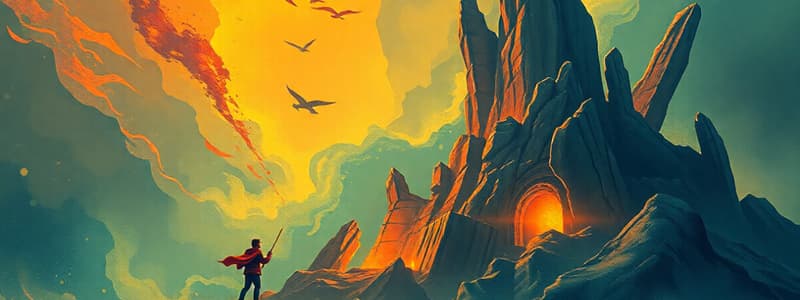Podcast
Questions and Answers
Which of the following is NOT a purpose of information?
Which of the following is NOT a purpose of information?
- To aid in monitoring and controlling performance
- To provide a sense of satisfaction (correct)
- To reduce uncertainty
- To serve as a means of communication
What is the primary difference between 'information literacy' and 'media literacy'?
What is the primary difference between 'information literacy' and 'media literacy'?
- Information literacy is a more advanced skill, while media literacy is considered basic.
- Media literacy primarily deals with visual information, while information literacy deals with written information.
- Information literacy focuses on assessing all types of information, while media literacy specifically analyzes media content. (correct)
- Media literacy encompasses both information and technology, while information literacy focuses on knowledge.
Which of these is NOT a type of information literacy?
Which of these is NOT a type of information literacy?
- Historical Literacy (correct)
- Digital Literacy
- Visual Literacy
- Traditional Literacy
What is the key characteristic that distinguishes a primary source from a secondary source?
What is the key characteristic that distinguishes a primary source from a secondary source?
Which of the following BEST describes the role of libraries in education?
Which of the following BEST describes the role of libraries in education?
Which of the following is NOT an example of a primary source?
Which of the following is NOT an example of a primary source?
What is the most significant impact of information literacy on higher education students?
What is the most significant impact of information literacy on higher education students?
Which of these is NOT considered a type of information source?
Which of these is NOT considered a type of information source?
Why is information literacy crucial for individuals living in the 21st century?
Why is information literacy crucial for individuals living in the 21st century?
Which of the following statements about libraries is FALSE?
Which of the following statements about libraries is FALSE?
Flashcards
Information
Information
Data, facts, and events about a topic, interpreted by recipients.
Purposes of Information
Purposes of Information
Functions like reducing uncertainty and aiding communication.
Information Literacy
Information Literacy
The ability to recognize when information is needed and how to effectively locate, evaluate, and use it.
Types of Information Literacy
Types of Information Literacy
Signup and view all the flashcards
Primary Information Sources
Primary Information Sources
Signup and view all the flashcards
Secondary Information Sources
Secondary Information Sources
Signup and view all the flashcards
Tertiary Information Sources
Tertiary Information Sources
Signup and view all the flashcards
Education
Education
Signup and view all the flashcards
Role of Libraries
Role of Libraries
Signup and view all the flashcards
Information Sources
Information Sources
Signup and view all the flashcards
Study Notes
Fundamentals of Information Literacy
- Information is crucial for individual, group, societal, organizational, and national development and prosperity.
- Information is data, facts, and events about a specific topic. It can be processed, interpreted, and used to make decisions.
- Information flows from a sender to a receiver using a medium/channel.
- Information reduces uncertainty, aids performance monitoring, and supports communication. It also serves as a memory tool, simplifies concepts, enhances understanding of the world, and supports decision-making.
- Information literacy is the ability to recognize when information is needed and effectively locate, evaluate, and utilize it. It involves critical thinking skills for interpreting and evaluating information.
- Information literacy is a multifaceted process involving identification, collection, organization, storage, retrieval, interpretation, dissemination, and utilization of information.
- Information literacy is vital, especially for students in higher education, enabling efficient information retrieval, evaluating credibility, and preparing for professional demands.
Types of Information Literacy
- Media Literacy - Analyzing various media forms.
- Digital Literacy - Effective use of digital tools and platforms.
- Visual Literacy - Interpreting and creating meaning from visual information.
- Traditional Literacy - Comprehension and communication through reading and writing skills.
- Computer Literacy - Understanding and operating basic ICTs (Information and Communication Technologies).
- Library Instruction - Evaluating and using library resources.
- Number Literacy - Using and interpreting numerical data.
- Alphabetical Literacy - Reading and writing skills.
- Network Literacy - Accessing and using electronic information.
Information Sources
- Information sources are the origins of information. Information is acquired, accessed, and disseminated through various channels (e.g., books, journals, interviews, newspapers, magazines, and digital platforms).
Types of Information Sources
- Primary Sources - First-hand and original information collected directly from the source (e.g., diaries, journals, interviews).
- Secondary Sources - Interpreted, analyzed, and summarized information from primary sources (e.g., textbooks, reviews).
- Tertiary Sources - Compiling and summarizing information from primary and secondary sources, providing digestible information (e.g., encyclopedias, bibliographies).
Education and Library
- Education is the process of gaining knowledge, skills, and values through various methods like teaching, training, discussions, and research.
- Formal education is from schools/universities; informal education comes from personal experience.
- Education's aim is intellectual and personal growth, skilled/analytical thinking, and active/informed citizenship.
- Libraries are essential components of education, providing resources for both learners and educators.
- Libraries offer extensive collections (print and digital), promoting research, teaching, and learning experiences.
- Libraries offer quiet and conducive study environments, helping students with information navigation and literacy development.
- Libraries promote lifelong learning and contribute to academic achievement.
Studying That Suits You
Use AI to generate personalized quizzes and flashcards to suit your learning preferences.




